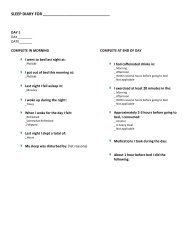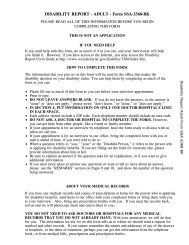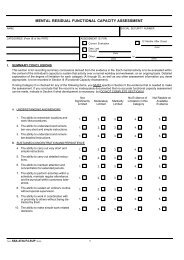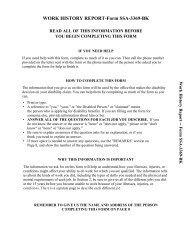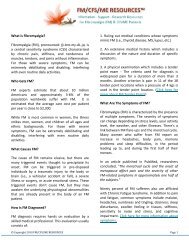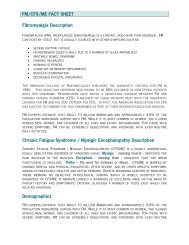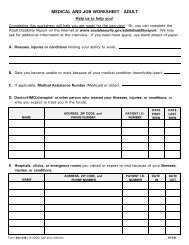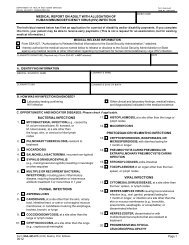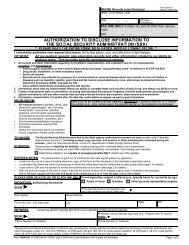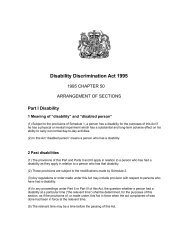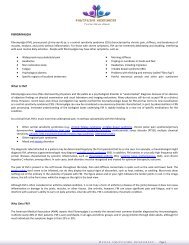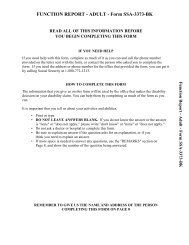THE ANTI-POLYMER ANTIBODY ASSAY (APA ASSAY) and ...
THE ANTI-POLYMER ANTIBODY ASSAY (APA ASSAY) and ...
THE ANTI-POLYMER ANTIBODY ASSAY (APA ASSAY) and ...
Create successful ePaper yourself
Turn your PDF publications into a flip-book with our unique Google optimized e-Paper software.
Autoimmune Technologies, LLC<br />
1010 Common Street, Suite 1705<br />
New Orleans, Louisiana 70112 U.S.A.<br />
www.autoimmune.com<br />
SCIENCE SUMMARY<br />
<strong>THE</strong> <strong>ANTI</strong>-<strong>POLYMER</strong> <strong>ANTI</strong>BODY <strong>ASSAY</strong> (<strong>APA</strong> <strong>ASSAY</strong>)<br />
<strong>and</strong><br />
FIBROMYALGIA SYNDROME<br />
The Anti-Polymer Antibody Assay, or <strong>APA</strong> Assay, detects an abnormal immune system<br />
response in most fibromyalgia patients. In one preclinical study, the titers of the antibodies detected<br />
correlated with nine separate clinical measures of fibromyalgia severity, including fatigue, stiffness,<br />
anxiety <strong>and</strong> depression. The <strong>APA</strong> Assay appears to be the first practical laboratory test for<br />
fibromyalgia, <strong>and</strong> the correlation between antibody titers <strong>and</strong> symptomatology appears to provide the<br />
first direct evidence that fibromyalgia syndrome is in fact a unique disease which is based on a<br />
physiological, <strong>and</strong> not a psychological, pathology.<br />
INTRODUCTION<br />
The Anti-Polymer Antibody Assay, or <strong>APA</strong> Assay, detects anti-polymer antibodies in the blood of<br />
most patients with fibromyalgia <strong>and</strong> fibromyalgia-like symptoms. Data presented in July 2004 at the<br />
International Myopain Society's Sixth World Congress on Myofascial Pain <strong>and</strong> Fibromyalgia described<br />
statistically significant relationships between the titers of these antibodies <strong>and</strong> nine different clinical<br />
measures of fibromyalgia severity. Previously published data strongly suggests that the presence of these<br />
antibodies distinguishes between patients with fibromyalgia <strong>and</strong> patients with connective tissue diseases<br />
such as systemic lupus erythematosus, systemic sclerosis, Sjögren's syndrome, rheumatoid arthritis, <strong>and</strong><br />
poly/dermatomyosis.<br />
The Company continues to gather research data using the <strong>APA</strong> Assay <strong>and</strong> is preparing further<br />
publications. In addition, the Company is commencing FDA clinical trials of the <strong>APA</strong> Assay Test Kit for<br />
use as an aid in diagnosing fibromyalgia, in differentiating fibromyalgia from other disorders which have<br />
similar symptoms, <strong>and</strong> in identifying those fibromyalgia patients who are manifesting this unique,<br />
symptom-associated immune response.<br />
The data presented in July 2004 was obtained from a study of well-characterized fibromyalgia<br />
patients which was conducted at the University of Texas Health Science Center in San Antonio (the "San<br />
Antonio study"). The San Antonio investigators were Yang-Ming Xiao, M.D., Ph.D., I. Jon Russell,<br />
M.D., Ph.D., <strong>and</strong> Joel E. Michalek, Ph.D. Dr. Russell is one of several world-recognized fibromyalgia<br />
experts, <strong>and</strong> Dr. Michalek is the principal investigator for the Air Force Ranch H<strong>and</strong> Study, which is the<br />
largest <strong>and</strong> longest-running epidemiological study in the United States. Manuscripts describing the San<br />
Antonio study are now being readied for publication.<br />
The <strong>APA</strong> Assay appears to be the first practical blood test for fibromyalgia. Until now,<br />
physicians have had only subjective measures available to assist them in identifying fibromyalgia<br />
patients. The Company believes the <strong>APA</strong> Assay to be a powerful tool which can be used by physicians to<br />
objectively identify fibromyalgia patients.
Science Summary - The <strong>APA</strong> Assay Page 2<br />
In part because of the historical absence of laboratory evidence to the contrary, many physicians<br />
currently feel that fibromyalgia is not a physically-based illness. These physicians instead believe that<br />
fibromyalgia is either a psychological disorder or that fibromyalgia symptoms are the product of some<br />
other disease which has not yet been correctly diagnosed. By directly associating immune response with<br />
symptomatology, the <strong>APA</strong> Assay demonstrates that fibromyalgia is in fact a unique physical disorder, or<br />
in lay terminology, "a real disease."<br />
The data from the San Antonio study suggests that anti-polymer antibodies might play a direct<br />
role in the fibromyalgia disease process. Data from this study as well as from previously published<br />
studies indicate that approximately one-half to two-thirds of primary fibromyalgia patients test positive<br />
for anti-polymer antibodies. Primary fibromyalgia syndrome is believed by many researchers to have<br />
more than one cause, <strong>and</strong> it is entirely possible that fibromyalgia patients who test positive for antipolymer<br />
antibodies represent a previously unrecognized majority group of fibromyalgia patients whose<br />
disease is the result of one particular cause.<br />
Drugs which modulate a patient's immune response are frequently prescribed by physicians to<br />
help alleviate symptoms in autoimmune disease patients. The <strong>APA</strong> Assay shows that a symptomassociated<br />
abnormal immune response is present in <strong>APA</strong>-positive fibromyalgia patients, <strong>and</strong> physicians<br />
could choose to interpret this finding as an indication that such drugs might also be useful in treating<br />
these patients.<br />
The titers of the antibodies detected by the <strong>APA</strong> Assay correlate with many measures of severity<br />
of symptoms of fibromyalgia. In contrast, other immunological test results rarely show any correlation at<br />
all between antibody titers <strong>and</strong> symptoms in any rheumatic disease. Because such correlations can in fact<br />
be explored by using the <strong>APA</strong> Assay, the test may also prove to be a valuable aid to physicians who wish<br />
to monitor symptom flare <strong>and</strong> other on-going conditions in their fibromyalgia patients.<br />
<strong>THE</strong> RESEARCH STUDIES<br />
An article published in the Journal of Rheumatology (1) entitled "Anti-Polymer Antibody<br />
Reactivity in a Subset of Patients with Fibromyalgia Correlates with Severity" shows that 47% of patients<br />
with fibromyalgia <strong>and</strong> 61% of patients with severe symptoms of fibromyalgia were seroreactive on the<br />
<strong>APA</strong> Assay. The pain thresholds, as determined by dolorimeter scores, for seropositive patients in the<br />
study were significantly lower than those of seronegative patients, demonstrating that <strong>APA</strong> reactivity<br />
correlates with severity of symptoms. No other reported laboratory measure has been found to correlate<br />
with severity of symptoms in patients with fibromyalgia.<br />
An earlier study of a different group of patients with fibromyalgia-like symptoms showed similar<br />
results. In an article published in The Lancet (2) entitled "Use of Anti-Polymer Antibody in Recipients of<br />
Silicone Breast Implants," 68% of patients with advanced fibromyalgia-like symptoms exhibited <strong>APA</strong><br />
Assay seroreactivity. The results of these two studies suggest that the presence of anti-polymer antibodies<br />
may serve as a laboratory marker for an illness that is the same or similar in both groups of patients. The<br />
<strong>APA</strong> Assay was also shown to be a very specific test, with a level of <strong>APA</strong> reactivity among patients (such<br />
as lupus patients) known not to have any fibromyalgia symptoms of approximately 3%.<br />
Both articles also present results showing that <strong>APA</strong> reactivity is markedly lower (p
Science Summary - The <strong>APA</strong> Assay Page 3<br />
erythematosus <strong>and</strong> systemic sclerosis/scleroderma, <strong>and</strong> it can be difficult, particularly in severe cases of<br />
fibromyalgia, to differentiate fibromyalgia from these diseases.<br />
The San Antonio study data presented in July 2004 at the Sixth World Conference on Myofascial<br />
Pain <strong>and</strong> Fibromyalgia (3) is entitled "Anti-Polymer Antibodies Identify a Large Subgroup of Fibromyalgia<br />
Syndrome Patients." The conclusions recited in the abstract are as follows:<br />
The presence <strong>and</strong> titer of <strong>APA</strong> correlate with clinical measures, suggesting that<br />
these antibodies identify a large, previously unrecognized subgroup of primary<br />
fibromyalgia syndrome (PFMS) patients <strong>and</strong> that <strong>APA</strong> may be important in the<br />
pathogenesis of that PFMS subgroup.<br />
In the San Antonio study, statistically significant correlations (p ≤ 0.05) were found between the<br />
optical densities of the ELISA test results (i.e., the antibody titers) <strong>and</strong> the following nine clinical<br />
measures of fibromyalgia severity:<br />
Measure Description Scale<br />
STIFF Degree of stiffness severity (VAS * ) 0 - 10<br />
FELTINAM Feeling from "good" to "bad" in the morning (VAS * ) 0 - 10<br />
HOWTIRED Degree of fatigue severity (VAS * ) 0 - 10<br />
LIMITACT Symptoms-limited-activity days experienced during the last week 0 - 7<br />
HEADACHE Days in which headache was experienced during the last week 0 - 7<br />
ANXIOUS Level of anxiety (VAS * ) 0 - 10<br />
DEPRESS Level of depression severity (VAS * ) 0 - 10<br />
ZUNG The Zung depression index 0 - 100<br />
CESD The Center for Epidemiological Studies depression index 0 - 60<br />
* As marked by the patient on a visual analog scale<br />
In addition, the correlation between antibody titers <strong>and</strong> a tenth clinical measure of fibromyalgia severity<br />
approached statistical significance at p = 0.06. This tenth measure was ABDMPAIN, which represents<br />
the number of days in which abdominal pain was experienced during the last week (3),(4) .<br />
Anti-polymer antibodies have also been shown to belong to the IgG2 subclass of human<br />
immunoglobulins, a subclass of IgG composed of antibodies that typically recognize non-peptide<br />
antigens (5) .<br />
In the San Antonio study, <strong>APA</strong> seroreactivity was found in approximately 26% of the population<br />
of relatively healthy normal controls. Subsequent analysis revealed that the <strong>APA</strong>-positive members of the<br />
control group exhibited a statistically-significant (p ≤ 0.05) increase in pain sensitivity as measured by<br />
dolorimeter, which suggests that anti-polymer antibodies are present in individuals with mild<br />
manifestations of fibromyalgia. A high <strong>APA</strong> reactivity rate among individuals who consider themselves<br />
to be healthy corresponds with the high rate of subclinical fibromyalgia found in studies by Clauw (6) <strong>and</strong><br />
by Wolfe et al (7) , which approached 20% of the adult female population in the United States.<br />
Anti-polymer antibodies were discovered at Tulane University Medical School, <strong>and</strong> the <strong>APA</strong><br />
Assay <strong>and</strong> has been licensed to Autoimmune Technologies, LLC of New Orleans. The <strong>APA</strong> Assay is<br />
currently covered by U.S., European <strong>and</strong> Australian patents, <strong>and</strong> other patents are pending.
Science Summary - The <strong>APA</strong> Assay Page 4<br />
The <strong>APA</strong> Assay is now being manufactured in commercial ELISA kit form. Because the <strong>APA</strong><br />
Test Kit is undergoing FDA clinical trials it cannot be distributed in the U.S., though it is available in<br />
other countries. Individual tests for anti-polymer antibodies can be conducted in nitrocellulose strip<br />
format by Autoimmune Technologies as a service to interested physicians <strong>and</strong> researchers for<br />
investigational use.<br />
For reprints or other information, please contact Russell B. Wilson, Ph.D., President <strong>and</strong> Chief<br />
Science Officer, Autoimmune Technologies, 144 Elks Place, Suite 1402, New Orleans, Louisiana 70112,<br />
USA. Telephone: (504) 529-9944 E-Mail: RBW@autoimmune.com Web: www.autoimmune.com<br />
Fax: (504) 529-8982<br />
REFERENCES<br />
1. Wilson, R. B., O. S. Gluck, J. R. P. Tesser, J. C. Rice, A. Meyer, <strong>and</strong> A. J. Bridges. Antipolymer<br />
Antibody Reactivity in a Subset of Patients with Fibromyalgia Correlates with Severity. Journal of<br />
Rheumatology 1999;26:402-407.<br />
2. Tenenbaum, S. A., J. C. Rice, L. R. Espinoza, M. L. Cuéllar, D. R. Plymale, D. M. S<strong>and</strong>er, L. L.<br />
Williamson, A. M. Haislip, O. S. Gluck, J. R. Tesser, L. Nogy, K. M. Stribrny, J. A. Bevan, <strong>and</strong> R. F.<br />
Garry. Use of Antipolymer Antibody Assay in Recipients of Silicone Breast Implants. The Lancet<br />
1997;349:449-454.<br />
3. Xiao Y. M., Russell I. J., Michalek, J. E. <strong>and</strong> Wilson, R.B. Anti-Polymer Antibodies Identify a Large<br />
Subgroup of Fibromyalgia Syndrome Patients. Presentation; Myopain 2004<br />
4. Xiao Y. M., Russell I. J., Michalek, J. E. <strong>and</strong> Wilson, R.B. Journal of Musculoskeletal Pain 2001,<br />
Volume 9, Supplement Number 5;106<br />
5. Wilson, R.B. Characterization of Anti-Polymer Antibodies Present in the Serum of Patients with<br />
Fibromyalgia Syndrome. Journal of Musculoskeletal Pain 2001, Volume 9, Supplement Number 5;105<br />
6. Clauw, D. J. The Pathogenesis of Pain <strong>and</strong> Fatigue Syndromes, with Special Reference to<br />
Fibromyalgia. Med Hypothesis 1995; 44:369-378<br />
7. Wolfe, F., K. Ross, J. Anderson, I. J. Russell, <strong>and</strong> L. Hebert. The Prevalence <strong>and</strong> Characteristics of<br />
Fibromyalgia in the General Population. Arthritis Rheum 1995;38:19-28.<br />
Rev. 12/07



